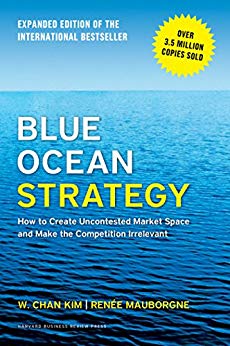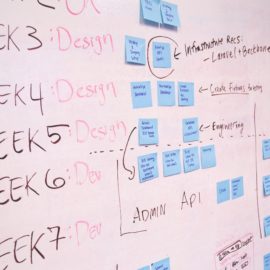

This article is an excerpt from the Shortform summary of "Blue Ocean Strategy" by W. Chan Kim and Renee Mauborgne. Shortform has the world's best summaries of books you should be reading.
Like this article? Sign up for a free trial here .
How do you design a blue ocean product? What is the key to creating a product in a yet uncontested market?
To begin brainstorming ideas for a blue ocean product offering, think of a product or service your company already sells, to use as a starting point. To help you come up with product ideas, Kim and Mauborgne explore some different approaches you can take to brainstorming.
Here are seven potential routes you could take to brainstorm a blue ocean product that sells.
1. Consider Your Customer’s Alternatives
When creating a blue ocean product, Kim and Mauborgne advise you to consider what alternatives your customers have for achieving the goal that your product fulfills. Especially consider alternatives that achieve the same end by different means. What are the key characteristics that might lead them to favor each alternative? How could you combine key characteristics from different options to create a new alternative that’s uniquely attractive?
For example, rock-climbing gear and video games are very different products that perform very different functions, but they are often used to fulfill the same basic goal of connecting with friends in a thrilling environment.
| Considering Your Market Alternatives In Crossing the Chasm, Moore approaches this subject from a slightly different angle. Specifically, where Kim and Mauborgne invite you to consider alternatives as a way to brainstorm new innovations, Moore assumes you’ve already got an innovative product, and considers alternatives from the perspective of figuring out where your product fits into the market. Thus, he advises that you think about what other functions your technology might be used for. For example, maybe you’ve been competing in the electric vehicle market, but then you realize that you could use the same basic technology to make electric farm tractors. If nobody else is currently doing that, your product would provide unique value. |
2. Consider How Customers Weigh Price Against Performance
According to Kim and Mauborgne, there are often groups of companies within an industry that pursue a similar strategy based on a balance of price and performance. For example, luxury car brands like Ferrari and Porsche could be considered one strategic group, while budget car brands would be another.
As with alternative industries above, consider what characteristics motivate your customers to buy from one strategic group over another, and then concentrate on delivering those characteristics while eliminating needless ones.
(Shortform note: In Positioning, marketing consultants Al Ries and Jack Trout assert that product maturity is often a key characteristic in how customers weigh price against performance. They say that if a product or technology is new and unproven, people tend to favor budget versions, because they can try it out without risking as much money on it. However, if the technology is mature, they are more receptive to premium versions. You can apply this to your own blue ocean product strategy by considering your product’s maturity and pricing accordingly.)
3. Consider Different Buyers in the Chain
Kim and Mauborgne point out that when looking for customers, companies often target the person with purchasing power. However, sometimes this is a different person with different preferences than the actual user. Consider targeting the end user’s pain points, or persistent problems, especially if they’ve traditionally been ignored, to create a product with unique value.
| Types of Buyers One of the key elements of Moore’s strategy is to identify a niche market of customers who have a compelling need that your product can meet. Thus, Moore echoes Kim and Mauborgne’s assertion that offering a unique solution to your customers’ pain points is a recipe for success. Moore differentiates between three types of buyers: 1) The economic buyer is the person who pays for the product or authorizes the purchase. 2) The technical buyer is the person who sets up the product so it can be used. 3) The end user, or functional buyer, is the person who uses the product once it’s set up. For example, suppose your son, who recently got his driver’s license, wants to take up off-roading, and he convinces you to buy a protective roll bar for his vehicle. You’re the one who pays for it, so you’re the economic buyer. The mechanic who installs the roll bar is the technical buyer. Your son is the end user, or functional buyer. |
4. Consider Complementary Products
Kim and Mauborgne note that products are rarely used in isolation. Consider what happens before, during, and after your product is used. Is there friction between any of these activities? If so, can you provide a bundled solution that would make things run more smoothly? Bundling complementary products to your product—even at cost—may add additional value.
For example, suppose you sell kitchen appliances, and you discover that your customers tend to juggle a phone or laptop while they’re cooking because they’re referring to recipes online. So you bundle a tablet PC with your appliances and provide a magnetic bracket to mount it conveniently on the refrigerator door.
(Shortform note: The authors’ recommendations for offering complementary products corresponds to another key element of Moore’s strategy: assembling the “whole product.” Like Kim and Mauborgne, Moore points out that your core product offering typically only provides part of the whole solution that the customer needs. For example, if your product is a smartphone, they also need a data plan to make use of it. In cases where it’s not practical to furnish the complete solution yourself, Moore recommends forming alliances with other companies who can provide the other pieces of the puzzle. This ensures that your customer can get the “whole product.”)
5. Consider Adding Function or Emotion
Kim and Mauborgne observe that most industries tend to gravitate toward either functionality or emotion.
For example, cosmetics tend to lean heavily toward emotion: They are designed and marketed under the assumption that people will buy them because they want to feel beautiful. Meanwhile, house paint leans more toward function: It is designed to provide objective benefits like durability, ease of application, and the ability to precisely match an existing color.
To innovate your product, Kim and Mauborgne recommend that you consider making an emotional product more functional by stripping away emotional trappings, or making a functional product more emotional. So, to continue our examples, what if you took a more objective, “house paint” approach to selling cosmetics by citing how long-lasting a product is? Or what if you created a line of “cosmetic” house paint that (together with your advertising) makes homeowners feel better about themselves and their homes for using it?
(Shortform note: Be careful not to go too far in the direction of functionality—sales expert Oren Klaff argues that to pitch a product successfully to a prospective customer, you must appeal to the primitive, emotional side of the brain first. Otherwise, it will filter out your message, and it will never reach the rational part of the brain. In light of this, making a functional product more emotionally engaging makes sense, but stripping away emotional frills to make a product more functional could be a risky proposition. If taken to the extreme, it might make it difficult to sell.)
6. Consider the Impact of Trends
Kim and Mauborgne assert that trends can inspire blue oceans, but they caution that blindly projecting current trends and trying to keep up with them is not a blue ocean strategy. Instead, they argue that only trends meeting the following criteria are meaningful:
- The trend must have a decisive impact on your industry. For example, if your business is building airplanes, trends in clothing fashion aren’t likely to affect you.
- The trend must be driven by forces or movements beyond your control (or your competitors’ control), such that it’s irreversible. For example, the trend toward globalization of commerce seems inevitable because it’s driven by human nature and market dynamics beyond any company’s control.
- The trend must have a clear direction. If you can’t tell where the trend is leading, then it’s not useful. For example, trends in clothing fashion rarely follow a predictable trajectory.
Once you’ve identified the relevant trends, the authors advise you to consider what the market will look like if the trend is taken to its logical conclusion. Then assess how you could tailor your product to provide unique value to the new markets the trend creates.
| The Key to Projecting Trends Management consultant David Mattin argues that there is a simple key to understanding trends so that you can use them to your advantage in business: Instead of focusing on how things change over time, learn what doesn’t change. Understanding constants like human nature allows you to predict how new developments will play out. This principle relates to all three of Kim and Mauborgne’s criteria for useful trends: 1) First, the experience and expertise you’ve gained in your industry so far is something you can’t go back and change. This is one reason to focus only on trends that impact your line of business. 2) When a trend is irreversible, it’s usually because the forces driving the trend are based on unchanging principles. If you understand the timeless constants of human nature, you’ll be in a good position to assess whether a trend is reversible or not. 3) If you understand the constant forces that are driving a trend, you’ll be able to extrapolate it to its logical conclusion. Understanding what won’t change is what allows you to predict what will, making the trend’s direction clear. |
7. Consider the Needs of Potential Customers
As you brainstorm ways to redefine the market, Kim and Mauborgne advise you to reach beyond existing demand and include potential customers in your assessment, as well as actual customers. If you can solve a problem that is preventing people from buying products in your industry, you may create a blue ocean product that attracts demand from both within and outside your industry. For example, drivers in rural areas generally consider electric vehicles out of the question because their typical driving distance is longer than the battery life of the vehicle. If you could produce an electric car that would go 600 miles between charges, you might be able to tap into a rural customer base.
The authors divide potential customers into three tiers:
- Tier 1 potential customers are existing customers in your market who aren’t happy with their current options and are waiting to jump at better alternatives.
- Tier 2 potential customers are people who have considered your industry’s options but have decided not to consume them because the current options don’t meet their needs.
- Tier 3 potential customers are people who have never thought of your industry’s products as an option.
Then they advise you to consider the commonalities between all three tiers to find their unmet pain points.
| Expanding Into Adjacent Niches Expanding your market to include additional customers is also a key element of Moore’s strategy, but he presents it as a phased process: First, you target a specific niche market of customers with a specific problem and focus on them exclusively until you become the market leader in that niche. (In Moore’s model, establishing market leadership in this niche first is important because it gives you greater credibility with mainstream customers.) Kim and Mauborgne’s Tier 1 potential customers—people hesitant to consume the current product offerings because of pain points that your product eliminates—seem like ideal candidates to target in this phase of Moore’s strategy. Once you’ve secured a leadership position in your niche, Moore then advises you to pick an adjacent niche to expand into, and focus your efforts there until you dominate that market sector as well. At this stage, you would likely be targeting Tier 2 and Tier 3 potential customers. To win the second tier, you’d need to convince them that your product solves the problems that prevented them from buying prior options. To win the third tier, you’d need to make them aware of your product and the value it offers for their application. After securing your second niche, you choose another, and so on, until you dominate the entire market for your type of product. |
———End of Preview———

Like what you just read? Read the rest of the world's best summary of "Blue Ocean Strategy" at Shortform . Learn the book's critical concepts in 20 minutes or less .
Here's what you'll find in our full Blue Ocean Strategy summary :
- What blue oceans are, and how you create one for your business
- Why some businesses succeed in creating blue oceans, and why others fail
- The red ocean traps you have to avoid if you want business growth






